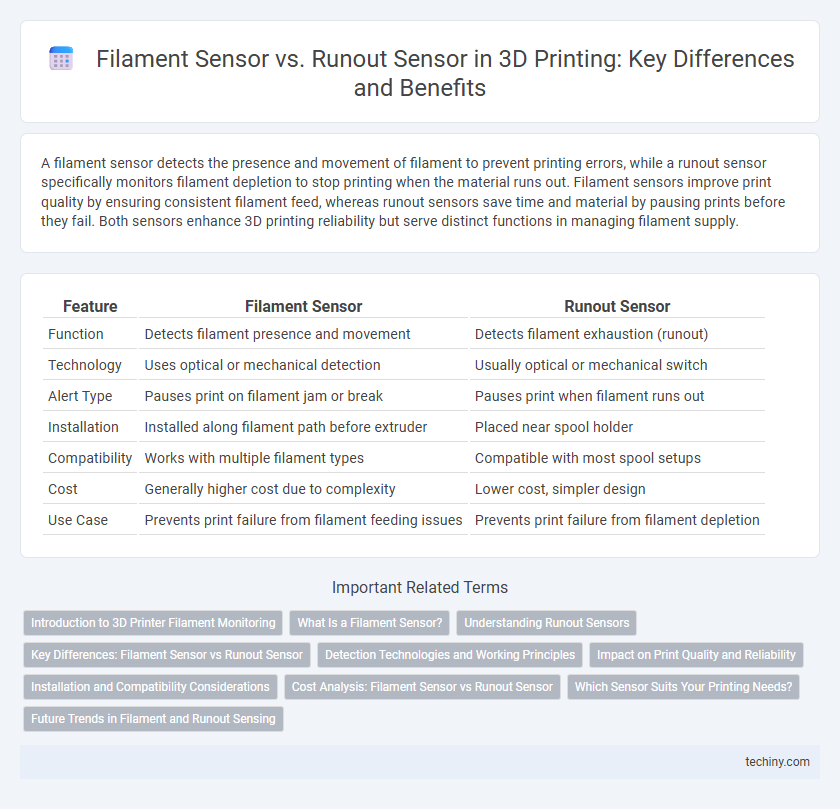A filament sensor detects the presence and movement of filament to prevent printing errors, while a runout sensor specifically monitors filament depletion to stop printing when the material runs out. Filament sensors improve print quality by ensuring consistent filament feed, whereas runout sensors save time and material by pausing prints before they fail. Both sensors enhance 3D printing reliability but serve distinct functions in managing filament supply.
Table of Comparison
| Feature | Filament Sensor | Runout Sensor |
|---|---|---|
| Function | Detects filament presence and movement | Detects filament exhaustion (runout) |
| Technology | Uses optical or mechanical detection | Usually optical or mechanical switch |
| Alert Type | Pauses print on filament jam or break | Pauses print when filament runs out |
| Installation | Installed along filament path before extruder | Placed near spool holder |
| Compatibility | Works with multiple filament types | Compatible with most spool setups |
| Cost | Generally higher cost due to complexity | Lower cost, simpler design |
| Use Case | Prevents print failure from filament feeding issues | Prevents print failure from filament depletion |
Introduction to 3D Printer Filament Monitoring
Filament sensors detect the presence and movement of 3D printer filament, ensuring continuous feeding by pausing the print when filament runs out or jams occur. Runout sensors specifically monitor filament depletion, triggering alerts or printer pauses to prevent failed prints due to empty spool detection. Both sensors enhance print reliability by providing real-time filament status monitoring, crucial for uninterrupted 3D printing processes.
What Is a Filament Sensor?
A filament sensor in 3D printing detects the presence and movement of filament to prevent print failures caused by filament jams or breaks. It ensures continuous filament feed by pausing the print job when the filament runs out or gets stuck, allowing users to replace the filament and resume printing seamlessly. Filament sensors differ from runout sensors by actively monitoring filament motion rather than just detecting if filament is present.
Understanding Runout Sensors
Runout sensors are specialized devices designed to detect when a 3D printer filament spool is empty or nearly depleted, preventing print failures by pausing the print job. Unlike general filament sensors that monitor filament presence continuously, runout sensors specifically focus on filament depletion events during printing. Integrating a reliable runout sensor ensures seamless print continuation and reduces material waste due to unexpected filament exhaustion.
Key Differences: Filament Sensor vs Runout Sensor
Filament sensors detect the presence and movement of filament to ensure continuous feeding during 3D printing, while runout sensors specifically detect when the filament has run out entirely to pause the print. Filament sensors provide real-time monitoring of filament flow and can prevent print failures caused by tangling or jams, whereas runout sensors primarily act as an alert system to stop printing when filament depletion occurs. Understanding these key differences helps optimize print reliability and material usage in 3D printing workflows.
Detection Technologies and Working Principles
Filament sensors typically use optical or mechanical detection technologies to monitor the presence and movement of filament, triggering pauses when the filament is depleted or broken. Runout sensors primarily rely on optical interruption methods to detect the absence of filament feeding into the extruder, ensuring print continuity by signaling the printer to halt or reload. Both sensors employ precise detection principles that enhance print reliability but differ in their positioning and specific function within the filament supply system.
Impact on Print Quality and Reliability
Filament sensors detect the presence and movement of filament, preventing print failures caused by filament jams or breaks, thereby enhancing print quality and reliability. Runout sensors specifically monitor filament depletion, pausing the print job to allow replacement, which ensures continuous printing without defects or layer shifts. Implementing both sensors reduces print interruptions and material waste, significantly improving overall 3D printing consistency and success rates.
Installation and Compatibility Considerations
Filament sensors typically require precise alignment with the filament path and are compatible with a wide range of extruders, making installation straightforward for most 3D printers. Runout sensors generally need integration at the filament spool holder and must support the printer's firmware to ensure accurate detection, which can complicate installation depending on the model. Compatibility considerations include verifying sensor support in the printer's electronics and firmware, with some sensors needing specific connectors or custom firmware updates for seamless functionality.
Cost Analysis: Filament Sensor vs Runout Sensor
Filament sensors generally incur higher costs due to their ability to detect filament type and diameter variations, offering enhanced print quality control. Runout sensors are more budget-friendly, primarily designed to detect filament depletion and trigger pause functions to prevent failed prints. Choosing between them depends on balancing upfront investment against advanced detection features and printing reliability.
Which Sensor Suits Your Printing Needs?
Filament sensors detect the presence and movement of filament to prevent printing pauses or failures due to filament breakage or depletion, making them ideal for consistent filament feed monitoring. Runout sensors specifically signal when the filament is completely exhausted, allowing the printer to pause and avoid unfinished prints, which suits long-duration projects requiring filament changes. Choosing between filament sensors and runout sensors depends on the need for continuous filament flow detection versus simple end-of-filament notifications for uninterrupted printing.
Future Trends in Filament and Runout Sensing
Future trends in filament and runout sensing focus on enhanced accuracy and integration with smart 3D printers, utilizing optical and magnetic detection technologies to prevent print failures. Advanced sensors are expected to support real-time filament quality analysis and adaptive printing adjustments, promoting higher efficiency and reduced material waste. The development of AI-driven algorithms combined with IoT connectivity will enable predictive maintenance and automated filament management.
Filament Sensor vs Runout Sensor Infographic

 techiny.com
techiny.com